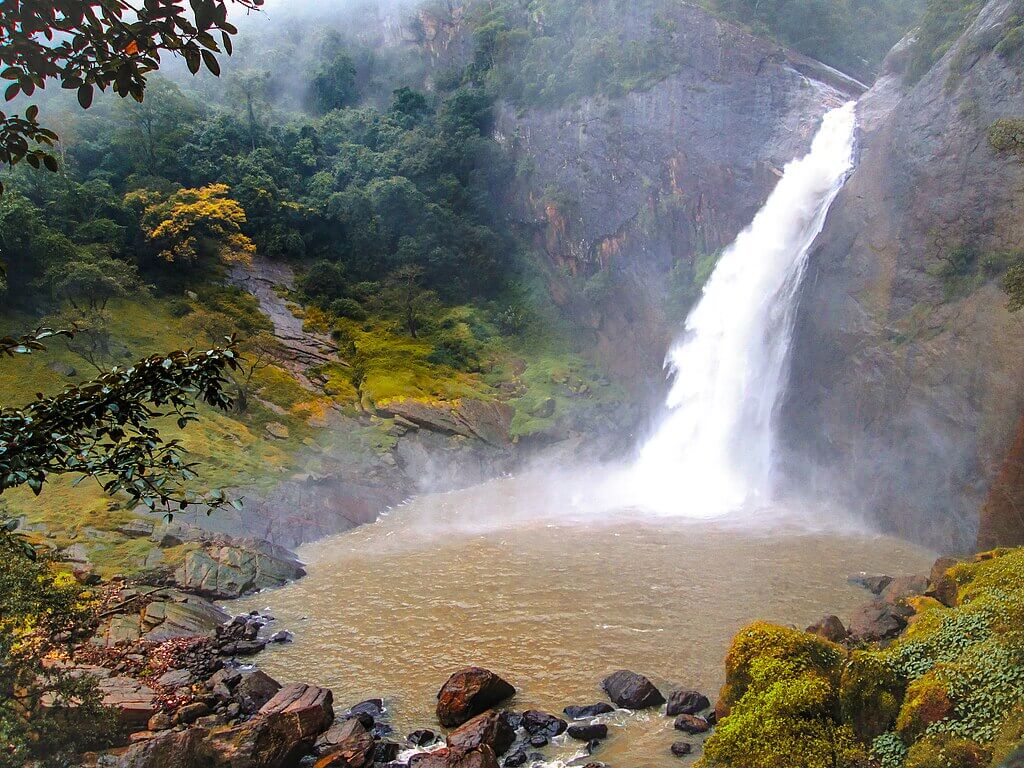Dunhinda Falls: The Veil of Mist

Photo by Nethmi Hasara licensed under CC-BY-SA-4.0
Why Is Everyone Talking About the “Smoky” Waterfall?
Imagine walking through a lush Sri Lankan forest, the air thick with the sweet smell of damp earth and wild blossoms. At first, it’s just a whisper, but with every step, the sound grows into a deep, powerful roar. You turn a corner, and there it is: a massive curtain of water, plunging 64 meters (≈210 feet) into a rocky pool, sending up a cloud of mist so dense it looks like smoke.
This is Dunhinda Falls. Its name perfectly captures its soul. In the local Sinhala language, “Dun” means smoke or mist, and “Hinda” means cascading. It’s not just the “Smoky Waterfall”; it’s a place that feels ancient and alive, a true jewel of Sri Lanka’s Uva Province. The journey to see it is just as magical as the destination itself.
The Complete Traveller’s Guide to Dunhinda
Best Time to Visit
The personality of Dunhinda Falls changes dramatically with the seasons. Your experience will depend entirely on when you go.
- June to September (Rainy Season): This is when Dunhinda is at its most ferocious and magnificent. The rains swell the Badulu Oya river, and the waterfall becomes a thundering spectacle. The downside? The 1.5 km path can be very slippery, muddy, and you might encounter a few leeches. The mist is so thick you’ll get soaked, but the power is unforgettable.
- December to April (Dry Season): The weather is far more pleasant for the walk. The path is dry, the skies are clearer, and the waterfall is more like a beautiful, lacy veil than a roaring beast. You can get closer and take clearer photos without your camera lens fogging up instantly. It’s less powerful but arguably more serene.
What to Do: The Journey is the Destination
The experience of Dunhinda begins the moment you leave the main road.
- The Trek: The walk to the falls is a gentle downhill journey of about 1.5 km. The path is lined with small stalls where friendly local vendors sell everything from herbal drinks and roasted corn to handmade crafts. It’s a wonderful opportunity to interact with the community.
- Spot Kuda Dunhinda: Before you reach the main event, you’ll pass a smaller but equally charming waterfall known as “Kuda Dunhinda” or “Little Dunhinda.” Think of it as the opening act for the spectacular show ahead.
- The Main Viewing Platform: This is where you get the iconic, postcard-perfect view. Feel the spray on your face, listen to the deafening roar, and just take in the raw power of nature. The mist swirls around you, creating a truly immersive experience. Be prepared to get wet!
Getting Around
Dunhinda Falls is located about 5 km from Badulla, a major town in the hill country.
- By Tuk-Tuk (Budget & Fun): The easiest and most popular way to get there from Badulla is by hiring a three-wheeler (tuk-tuk). It’s a short, breezy ride, and every driver knows the way. Agree on a price beforehand.
- By Bus (Local Experience): For a more local and cheaper option, you can hop on a bus heading towards Mahiyanganaya from Badulla and ask the driver to drop you at the Dunhinda junction. From there, it’s a short walk to the ticket counter and the start of the trail.
Travel Tips
- Wear Sturdy Shoes: The path can be uneven and slippery, especially after rain. Good walking shoes with a solid grip are a must.
- Protect Your Gear: The mist is no joke! Bring a waterproof bag or cover for your phone and camera. A lens cloth is also a great idea.
- Watch for Monkeys: The area is home to playful but mischievous monkeys. Keep your snacks and shiny objects safely tucked away in your bag.
- Stay Hydrated: The walk back up is all uphill. Buy a fresh king coconut (thambili) from a vendor on the way down to rehydrate for the return journey. It’s natural, refreshing, and supports the local economy.
Whispers from the Past
Dunhinda is steeped in history and folklore. The land around the falls was once the domain of the Vedda people, the indigenous forest-dwellers of Sri Lanka.
- A Royal Hideout: Legend says that a local king, Valagamba, hid in the caves behind the waterfall while escaping from invaders. Another tale speaks of a giant fern that once blocked the falls, which was later removed, revealing the treasure of a princess hidden within.
- Impressions of a Bygone Era: Imagine an early British colonial explorer, guided by locals, hacking his way through the dense jungle. He would have written in his journal of a “great smoky cascade, its roar heard miles before it was seen, a formidable and wild sight.” While the path is much clearer today, that sense of wildness and discovery remains.
Your Journey Awaits
A trip to Dunhinda Falls is more than just a photo opportunity. It’s a sensory experience – the sound of the water, the feel of the mist, the taste of a freshly roasted corn on the cob, and the warm smiles of the people you meet along the path. It’s a small adventure that connects you to the raw, untamed beauty of Sri Lanka.